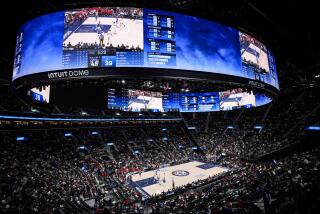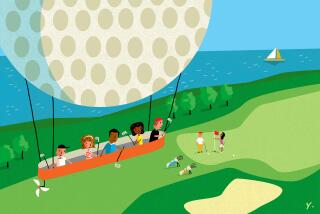Simply Grand
- Share via
There is a certain irony to Olympia Fields’ modern status as an internationally known club and U.S. Open venue, because its founder initially seems to have favored a less ambitious approach. “Golf for golf’s sake” is how Charles Beach first described his planned establishment, and while such a concept embraced the idea of multiple courses, it also favored the sort of spartan amenities more suited to old Scotland than a Golden Age American country club. Accommodations for weekend and summer visits would be provided by log cabins, meals by a communal cafeteria. The locker room, Beach figured, would be little more than a place to change one’s shoes.
But apparently as the No. 1 course opened in 1916, the club’s immediate popularity sparked a change. With University of Chicago football coach Amos Alonzo Stagg serving as president, new members flocked aboard, taking Olympia Fields irreversibly away from Beach’s early vision, onto a road of unparalleled grandeur and luxury. Despite this blazing start, development soon suffered a brief detour because of World War I. According to the American Golfer magazine, “By the Autumn of 1917 the second course was opened but the war stopped all construction. Olympia used its broad acres for the growing of wheat and all along the fairways grew golden grain. President Stagg led bankers, lawyers and doctors into the rough for the harvest!”
But with the end of hostilities and the onset of the Roaring ‘20s, things shifted quickly back into gear. By 1920, the long and challenging No. 3 course was open, followed, two years later, by Willie Park’s famed No. 4, the site of this week’s national championship.
Olympia Fields, becoming the first private club in the world to offer 72 holes, clearly felt the need to bring its other facilities to a comparable level.
What followed was not so much the creation of a large country club as it was a small community. Serviced by its own station along the Illinois Central rail line, the club’s 750 acres soon featured a school, medical facility, fire station and ice-making plant, plus some 65 summer cottages for overnight guests. Tennis courts opened in 1921 and were followed by facilities for swimming, riding, polo, shooting, archery, outdoor dancing and a variety of other warm-weather pursuits. Given the Chicago area’s winters, as well as the club’s desire to serve its members on a year-round basis, provisions were soon made for skiing, skating and tobogganing as well.
Few of those facilities remain today, but the eventual centerpiece, the world’s largest golf clubhouse, certainly does. In his 1991 book “Chicago Golf: The First 100 Years,” author Tom Govedarica wrote: “Built in 1925, at a cost exceeding $1 million, the mammoth edifice stretched the length of a football field. The main dining room alone was large enough to seat 1,400. Locker facilities for 1,200 were available, as were 70 private sleeping rooms. Naturally, there was also a lounge where beverages of choice were served -- it was referred to as the club’s 73rd hole.”
Govedarica also notes that the club’s grounds “were a naturalist’s delight,” serving as home to more than 60 species of birds amid its 10,000 trees. Also inhabited by deer, turkey, pheasant and the like, the property was authorized by the State of Illinois as an official game preserve, though this status was apparently short-lived. But as the club’s original raison d’etre, golf reigned supreme at Olympia Fields, with all four courses standing as high-octane tests. The No. 1, a stout 6,596-yarder designed by Tom Bendelow, remains largely intact today as the club’s South Course. The No. 2, designed by Scotsman Willie Watson, was the shortest of the bunch at 6,330 yards but offered several difficult holes. The No. 3, a collaboration between Bendelow and Watson, was a tough, rolling track occupying the property’s eastern reaches. Measuring 6,418 yards with a par of 70, it was remodeled by club professional Jack Daray -- primarily to make it easier -- in the late 1920s.
Finally, Park’s daunting No. 4 is today’s North Course, a tree-lined, creek-menaced affair that, despite numerous added bunkers and rebuilt greens, retains a good deal of Park’s original flavor.
Like so many clubs, Olympia Fields was affected by the Depression and World War II. Unable to cover its obligations, the membership chose to assure long-term survival (and eliminate its considerable debt) by selling off the Nos. 2 and 3 courses to real estate developers in the early 1940s.
What we shall see before us this week, then, is one of America’s finest 36-hole country clubs -- but only a fraction of the splendor that once made Olympia Fields the grandest golfing venue of all.
More to Read
Sign up for The Wild
We’ll help you find the best places to hike, bike and run, as well as the perfect silent spots for meditation and yoga.
You may occasionally receive promotional content from the Los Angeles Times.






